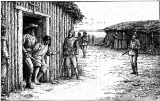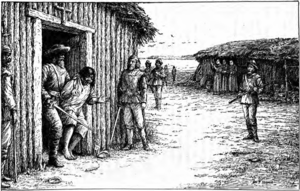
Fernando Rivera y Moncada
Encyclopedia
Fernando Javier Rivera y Moncada (c. 1725 – July 18, 1781) was a soldier from New Spain
who served in the Baja California peninsula
and upper Las Californias
, participating in several early overland explorations. Fernando Rivera y Moncada served as a Spanish Miilitary Governor from 1774-1777.
, New Spain. He entered military service in 1742, serving harmoniously under Jesuit
direction in Baja California. In 1750 he was promoted to command of the presidio
at Loreto
. He participated in the important reconnaissances of the northern peninsula together with the Jesuit missionary-explorers Ferdinand Konščak
and Wenceslaus Linck
. Rivera's situation changed in 1768 when the Jesuits were expelled
and replaced in Baja California by the Franciscans and by the civil authorities of New Spain
. The latter ordered a bold move northward to colonize Alta California
.
 In 1769, Rivera led the first overland party to San Diego
In 1769, Rivera led the first overland party to San Diego
, together with Juan Crespi
and José Cañizares, traveling in advance of the party led by Gaspar de Portolà
and Junípero Serra
. After the several land and sea groups assembled again at San Diego, Rivera continued north with Portolà to Monterey
. Rivera retired to the Mexican mainland around 1772, but he was soon recalled to service. Serra and the Franciscans had quarreled with California's military governor, Pedro Fages
, and Rivera took over as Fages' replacement in 1774. The results were not happy. Rivera himself was soon in conflict with Serra and the Franciscans and with Juan Bautista de Anza
. Rivera opposed the settlement of San Francisco
. When several Kumeyaay
Indian communities joined together to sack the mission at San Diego
in 1775, Rivera had the responsibility of suppressing the revolt. For forcibly removing one of the rebels from a temporary church building at the mission, Rivera was excommunicated by the Franciscans.
Following his tenure as governor in 1777, Rivera was reassigned as military commander at Loreto. His final posting was centered on assisting settlers as they made their way overland to California. Rivera was killed along with the local missionaries, settlers, and travelers at Mission San Pedro y San Pablo de Bicuñer on the lower Colorado River
with the revolt of the Quechan
Indians in 1781.
New Spain
New Spain, formally called the Viceroyalty of New Spain , was a viceroyalty of the Spanish colonial empire, comprising primarily territories in what was known then as 'América Septentrional' or North America. Its capital was Mexico City, formerly Tenochtitlan, capital of the Aztec Empire...
who served in the Baja California peninsula
Baja California Peninsula
The Baja California peninsula , is a peninsula in northwestern Mexico. Its land mass separates the Pacific Ocean from the Gulf of California. The Peninsula extends from Mexicali, Baja California in the north to Cabo San Lucas, Baja California Sur in the south.The total area of the Baja California...
and upper Las Californias
Las Californias
The Californias, or in — - was the name given by the Spanish to their northwestern territory of New Spain, comprising the present day states of Baja California and Baja California Sur on the Baja California Peninsula in Mexico; and the present day U.S. state of California in the United States of...
, participating in several early overland explorations. Fernando Rivera y Moncada served as a Spanish Miilitary Governor from 1774-1777.
Biography
Rivera was born near CompostelaCompostela, Nayarit
Compostela is the name of both a municipality and the town within that municipality that serves as the seat. They are in the Mexican state of Nayarit. The population of the municipality was 62,925 in a total area of 1,848 km²...
, New Spain. He entered military service in 1742, serving harmoniously under Jesuit
Society of Jesus
The Society of Jesus is a Catholic male religious order that follows the teachings of the Catholic Church. The members are called Jesuits, and are also known colloquially as "God's Army" and as "The Company," these being references to founder Ignatius of Loyola's military background and a...
direction in Baja California. In 1750 he was promoted to command of the presidio
Presidio
A presidio is a fortified base established by the Spanish in North America between the sixteenth and nineteenth centuries. The fortresses were built to protect against pirates, hostile native Americans and enemy colonists. Other presidios were held by Spain in the sixteenth and seventeenth...
at Loreto
Loreto, Baja California Sur
Loreto was the first Spanish settlement on the Baja California Peninsula. It served as the capital of Las Californias from 1697 to 1777, and is the current seat of the municipality of Loreto in the Mexican state of Baja California Sur...
. He participated in the important reconnaissances of the northern peninsula together with the Jesuit missionary-explorers Ferdinand Konščak
Ferdinand Konšcak
Ferdinand Konščak was a Jesuit missionary, explorer, and cartographer.-Education:...
and Wenceslaus Linck
Wenceslaus Linck
Wenceslaus Linck was the last of the outstanding Jesuit missionary-explorers in Baja California.Born in Bohemia , he entered the Jesuit order at age 18 and studied at Brno and Prague. In New Spain, he continued his studies in Mexico City and Puebla between 1756 and 1761...
. Rivera's situation changed in 1768 when the Jesuits were expelled
Suppression of the Jesuits
The Suppression of the Jesuits in the Portuguese Empire, France, the Two Sicilies, Parma and the Spanish Empire by 1767 was a result of a series of political moves rather than a theological controversy. By the brief Dominus ac Redemptor Pope Clement XIV suppressed the Society of Jesus...
and replaced in Baja California by the Franciscans and by the civil authorities of New Spain
New Spain
New Spain, formally called the Viceroyalty of New Spain , was a viceroyalty of the Spanish colonial empire, comprising primarily territories in what was known then as 'América Septentrional' or North America. Its capital was Mexico City, formerly Tenochtitlan, capital of the Aztec Empire...
. The latter ordered a bold move northward to colonize Alta California
Alta California
Alta California was a province and territory in the Viceroyalty of New Spain and later a territory and department in independent Mexico. The territory was created in 1769 out of the northern part of the former province of Las Californias, and consisted of the modern American states of California,...
.

San Diego, California
San Diego is the eighth-largest city in the United States and second-largest city in California. The city is located on the coast of the Pacific Ocean in Southern California, immediately adjacent to the Mexican border. The birthplace of California, San Diego is known for its mild year-round...
, together with Juan Crespi
Juan Crespi
Father Juan Crespí was a Majorcan missionary and explorer of Las Californias. He entered the Franciscan order at the age of seventeen. He came to America in 1749, and accompanied explorers Francisco Palóu and Junípero Serra. In 1767 he went to the Baja Peninsula and was placed in charge of the...
and José Cañizares, traveling in advance of the party led by Gaspar de Portolà
Gaspar de Portolà
Gaspar de Portolà i Rovira was a soldier, governor of Baja and Alta California , explorer and founder of San Diego and Monterey. He was born in Os de Balaguer, province of Lleida, in Catalonia, Spain, of Catalan nobility. Don Gaspar served as a soldier in the Spanish army in Italy and Portugal...
and Junípero Serra
Junípero Serra
Blessed Junípero Serra, O.F.M., , known as Fra Juníper Serra in Catalan, his mother tongue was a Majorcan Franciscan friar who founded the mission chain in Alta California of the Las Californias Province in New Spain—present day California, United States. Fr...
. After the several land and sea groups assembled again at San Diego, Rivera continued north with Portolà to Monterey
Monterey, California
The City of Monterey in Monterey County is located on Monterey Bay along the Pacific coast in Central California. Monterey lies at an elevation of 26 feet above sea level. As of the 2010 census, the city population was 27,810. Monterey is of historical importance because it was the capital of...
. Rivera retired to the Mexican mainland around 1772, but he was soon recalled to service. Serra and the Franciscans had quarreled with California's military governor, Pedro Fages
Pedro Fages
Pere Fages Beleta , nicknamed L'Ós , was a soldier, explorer, and the second Spanish military Governor of Las Californias Province of New Spain from 1770 to 1774, and the Governor of Las Californias from 1782 to 1791.-Life:...
, and Rivera took over as Fages' replacement in 1774. The results were not happy. Rivera himself was soon in conflict with Serra and the Franciscans and with Juan Bautista de Anza
Juan Bautista de Anza
Juan Bautista de Anza Bezerra Nieto was a Novo-Spanish explorer and Governor of New Mexico for the Spanish Empire.-Early life:...
. Rivera opposed the settlement of San Francisco
San Francisco, California
San Francisco , officially the City and County of San Francisco, is the financial, cultural, and transportation center of the San Francisco Bay Area, a region of 7.15 million people which includes San Jose and Oakland...
. When several Kumeyaay
Kumeyaay
The Kumeyaay, also known as Tipai-Ipai, Kamia, or formerly Diegueño, are Native American people of the extreme southwestern United States and northwest Mexico. They live in the states of California in the US and Baja California in Mexico. In Spanish, the name is commonly spelled...
Indian communities joined together to sack the mission at San Diego
Mission San Diego de Alcalá
Mission Basilica San Diego de Alcalá, in San Diego, California, was the first Franciscan mission in the Las Californias Province of the Viceroyalty of New Spain. It was founded in 1769 by Spanish friar Junípero Serra in an area long inhabited by the Kumeyaay Indians...
in 1775, Rivera had the responsibility of suppressing the revolt. For forcibly removing one of the rebels from a temporary church building at the mission, Rivera was excommunicated by the Franciscans.
Following his tenure as governor in 1777, Rivera was reassigned as military commander at Loreto. His final posting was centered on assisting settlers as they made their way overland to California. Rivera was killed along with the local missionaries, settlers, and travelers at Mission San Pedro y San Pablo de Bicuñer on the lower Colorado River
Colorado River
The Colorado River , is a river in the Southwestern United States and northwestern Mexico, approximately long, draining a part of the arid regions on the western slope of the Rocky Mountains. The watershed of the Colorado River covers in parts of seven U.S. states and two Mexican states...
with the revolt of the Quechan
Quechan
The Quechan are a Native American tribe who live on the Fort Yuma Indian Reservation on the lower Colorado River in Arizona and California just north of the border with Mexico...
Indians in 1781.

